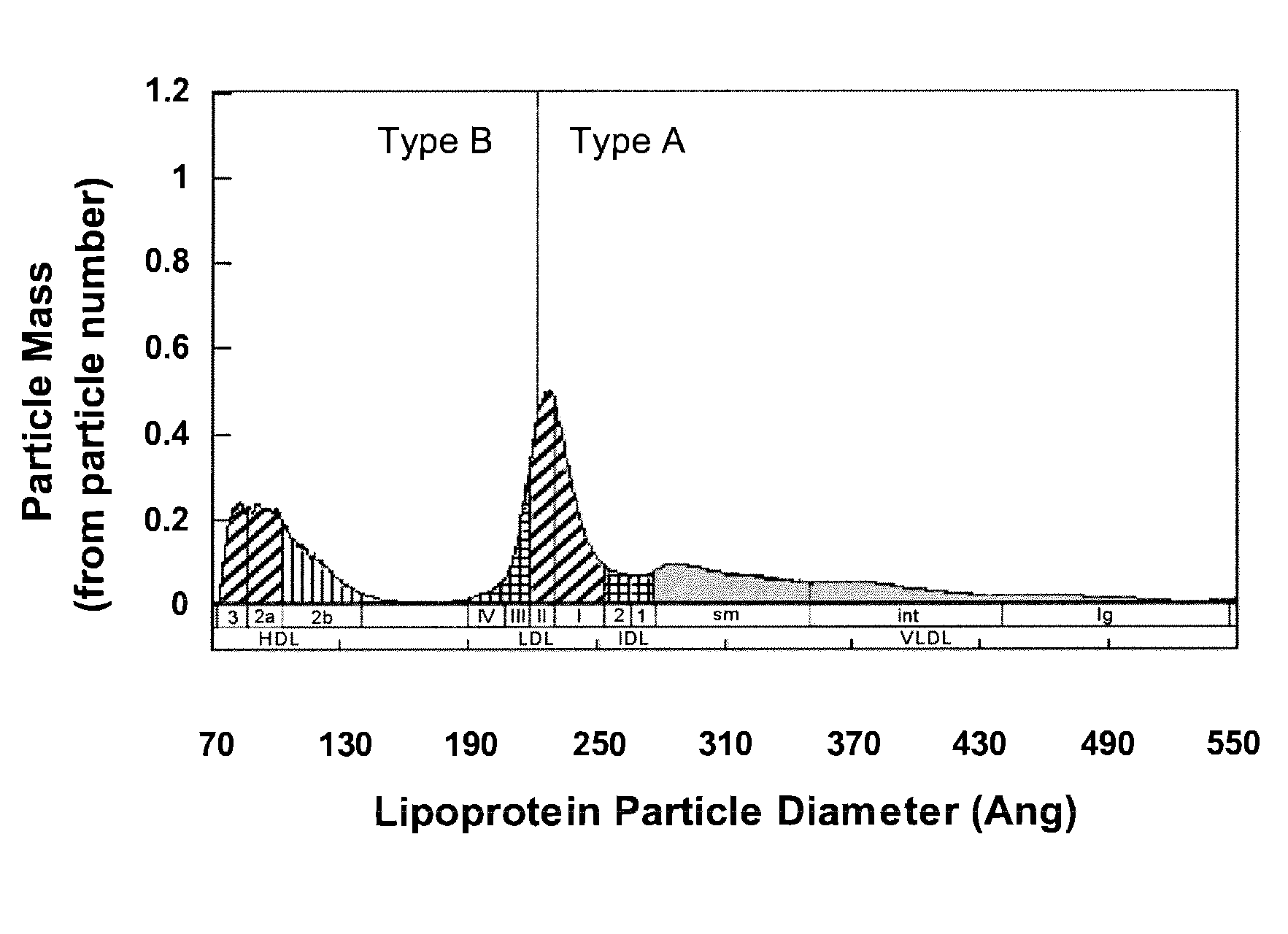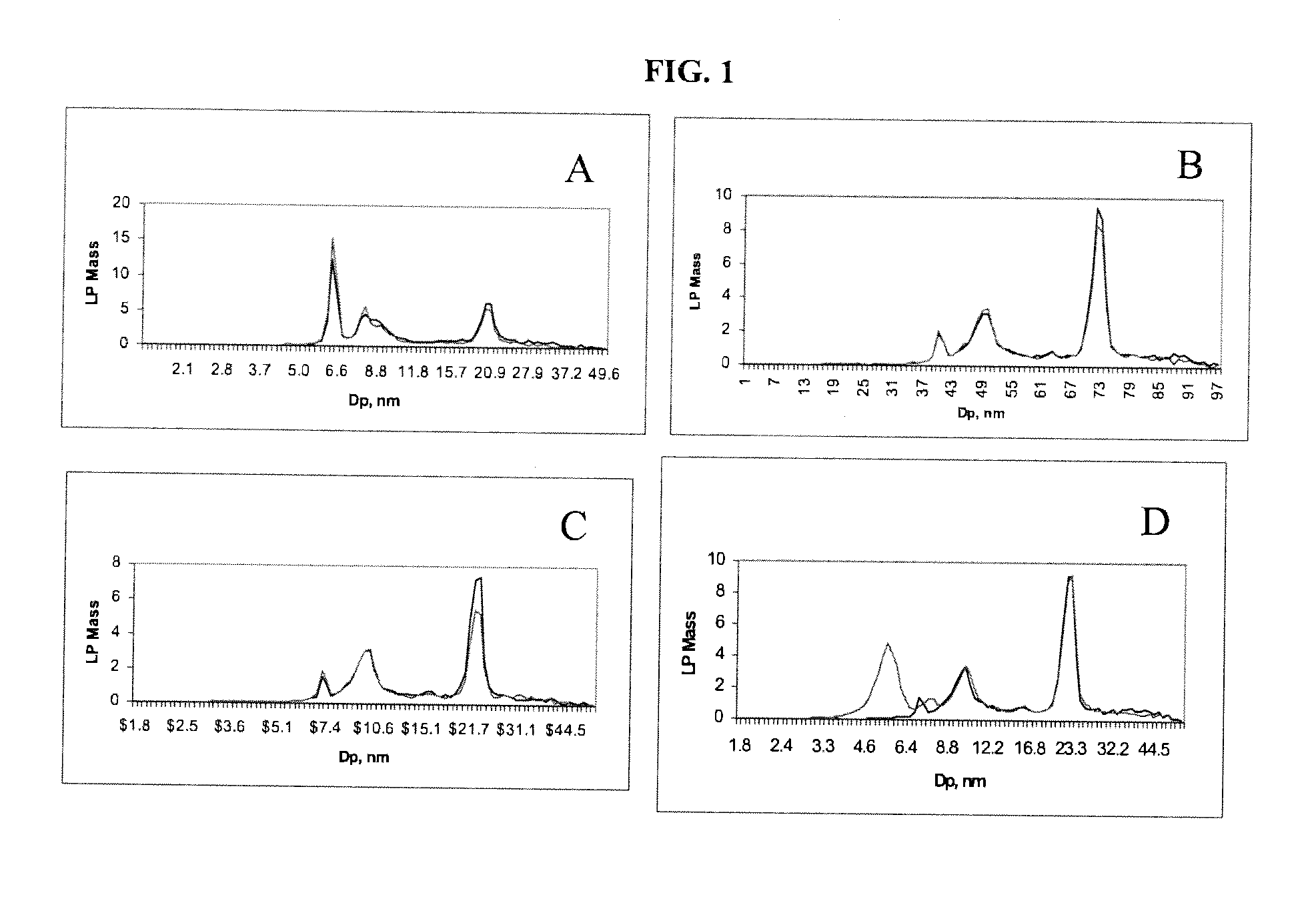Lipoprotein analysis by differential charged-particle mobility
a technology of differential charge and particle mobility, applied in the field of biological particle particle size analysis and analysis, can solve the problems of inability to accurately detect the whole picture of cholesterol and lipoprotein measurement, limited accuracy of friedewald method, and errors in any three steps, so as to reduce the density of lipoprotein-containing solutions, improve the recovery of certain fractions of lipoprotein, and improve the effect of lipid conten
- Summary
- Abstract
- Description
- Claims
- Application Information
AI Technical Summary
Benefits of technology
Problems solved by technology
Method used
Image
Examples
example 1
Comparison of Lipoprotein Purification Using D2O and Low-Salt Solution
[0090]A serum sample (25 uL) was processed either using a low-density salt solution (1.151 g / mL) (i.e., “low-density salt sample”) or D2O (200 uL each). Samples were centrifuged at 223,000×G for 3.7 hr (low-density salt sample) or 2 hr (D2O). Following removal of the top 100 uL after centrifugation, the low-density salt sample was dialyzed against ammonium acetate solution and diluted to 1:200 before ion mobility analysis. The D2O sample was diluted directly after centrifugation to 1:200 with ammonium acetate prior to ion mobility analysis. Results of ion mobility analysis are presented in FIG. 2.
example 2
Effect of Purification on Apo A, Apo B, and TC Recovery
[0091]To assess whether HDL (Apo A1) was preferentially lost in procedures employing D2O, three samples as shown in FIG. 3 (i.e., 749, 1043, 14: arbitrary and unique patient identification numbers) were subjected to lipoprotein isolation employing D2O together with RGD / DS solution (7.5 / 2.5 mg / mL, respectively) to remove albumin. Samples were each prepared in replicates of six. The isolated individual top 100 uL were each analyzed for content of Apo A1 (HDL), Apo B (LDL, IDL, VLDL) and total cholesterol (TC). Plasma or serum apolipoproteins A1 and B were measured by standardized ELISA using commercially available monoclonal capture antibodies (Biodesign International, Saco, Minn.) and anti-human goat polyclonal detection antibodies, purified and biotinylated, (International Immunology Corp., Murrieta, Calif.) in a non-competitive sandwich-style immunoassay. Concentration was measured by addition of streptavidin conjugated peroxid...
example 3
Effect of Varying RGD on Lipoprotein Fraction Recovery
[0092]A serum sample was mixed with varying amounts of RGD (10, 15, 20, 25 mg / mL) and incubated on ice for 15 min before being overlaid on a cushion of D2O. After centrifuging for 120 min at 223,000×G, the top 100 uL was removed and diluted 1:200 with ammonium acetate solution. Samples were then analyzed by ion mobility analysis. Results are shown in FIG. 4.
PUM
| Property | Measurement | Unit |
|---|---|---|
| Density | aaaaa | aaaaa |
| Density | aaaaa | aaaaa |
| Density | aaaaa | aaaaa |
Abstract
Description
Claims
Application Information
 Login to View More
Login to View More - R&D
- Intellectual Property
- Life Sciences
- Materials
- Tech Scout
- Unparalleled Data Quality
- Higher Quality Content
- 60% Fewer Hallucinations
Browse by: Latest US Patents, China's latest patents, Technical Efficacy Thesaurus, Application Domain, Technology Topic, Popular Technical Reports.
© 2025 PatSnap. All rights reserved.Legal|Privacy policy|Modern Slavery Act Transparency Statement|Sitemap|About US| Contact US: help@patsnap.com



